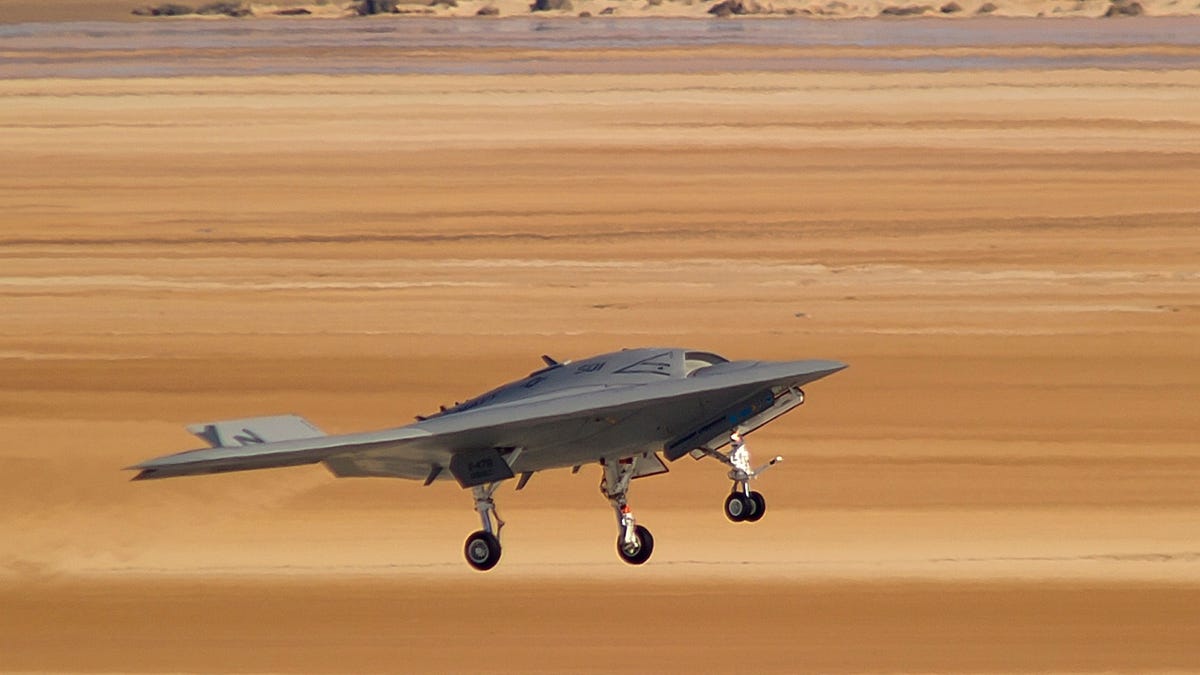X-47B robo-plane takes (flying) wing again
Making its second and third dry runs in the desert, the Northrop Grumman prototype is in the early stages of gearing up for eventual maneuvers on an aircraft carrier.

Almost from the very beginning seven decades ago, flying wings have been something of a specialty for the aircraft company founded by Jack Northrop.
The 1940s saw the XB-35 experimental aircraft. The late 1980s brought the B-2 bomber.
Now Northrop Grumman is pushing ahead with the X-47B UCAS (for unmanned combat air system), a prototype going through its fledgling stage en route to the goal of demonstrating in 2013 that an unmanned, tailless, strike fighter-size aircraft can land on and take off from an aircraft carrier.
Earlier this month, the X-47B made just the second and third flights (from dry land) of its young career, not long after completing its maiden flight in early February. With the pair of flights, both of which took place in the first week of March at Edwards Air Force Base in California, Northrop Grumman said yesterday that it has begun the process of "envelope expansion" that will take the UAV through a range of altitudes, air speeds, and operating weights.
Both flights saw the X-47B reach an altitude of 7,500 feet, up from the 5,000-foot accomplishment in its February debut. It flew as fast as 200 knots in the March 1 flight, which lasted 39 minutes, and up to 180 knots on March 4 over about 41 minutes. One of the results that pleased Northrop Grumman is that the flush-mounted air data system, an aspect of its stealthy, low-profile design, was able to accurately sense and communicate air speed.
The envelope expansion phase will entail a planned 49 flights at Edwards AFB, over the course of which the flight requirements will get more and more complex, before the X-47B moves to the Naval Air Station at Patuxent River, Md., later this year.
Northrop Grumman's contract with the U.S. Navy calls for two aircraft, not just this first one. The second one, referred to as AV-2, is still at the company's assembly and test facility in Palmdale, Calif., where it recently wrapped up stress tests intended to show that the airframe can tolerate the rigors of combat maneuvers--tests included those mimicking a 3-G symmetrical pull-up and a 2.4-G rolling pullout--and of using an aircraft carrier as its runway.
"The proof tests validate the structural design of the aircraft, and give us confidence that we can operate this plane safely and reliably in all anticipated carrier environments," said Janis Pamiljans, vice president of the Navy UCAS program for Northrop Grumman's Aerospace Systems sector, in a statement earlier this week. "In particular, we now know that AV-2 can handle the stresses, strains and dynamic loads associated with catapult launches and arrested landings on the carrier deck, and air-to-air refueling."
About that air-to-air refueling: The two X-47B aircraft are identical, the company says, except that AV-2 will be kitted out with aerial refueling equipment, with the goal of demonstrating unmanned aerial refueling in 2014. Northrop Grumman is also working on an aerial refueling project, under the auspices of the DARPA KQ-X program, that aims for an autonomous fill-up involving a pair of Global Hawk UAVs in 2012.
The AV-2 aircraft will head to Edwards AFB later this spring.

